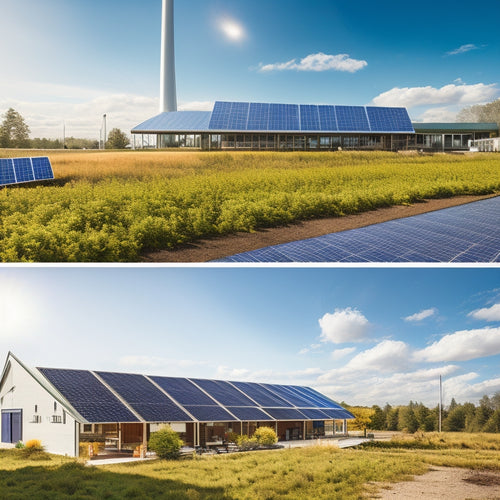
How to Get Solar Panel Money From the Government
Share
You're eligible to claim government incentives worth thousands of dollars when you invest in solar panels for your home or business. The Solar Investment Tax Credit (ITC) offers a 26% credit for residential and commercial solar installations, reducing your tax liability. Additionally, rebate programs from utility companies, state governments, and non-profits can provide further financial benefits. State and local incentives, such as property tax exemptions, can also offset upfront costs. To maximize your savings, it's crucial to understand the various programs available and their eligibility criteria. Now, investigate the specific incentives that can help you save the most on your solar panel installation.
Key Takeaways
- The Solar Investment Tax Credit (ITC) offers a 26% tax credit for residential and commercial solar installations, reducing upfront costs.
- Rebate programs from utility companies, state governments, and non-profits provide additional financial incentives for solar panel installations.
- State and local governments offer incentives, such as property tax exemptions and rebates, to offset solar installation costs.
- The USDA provides grants and loans for rural businesses and agricultural producers to support solar energy systems through the REAP program.
- Accurate record-keeping of eligible solar expenses is essential to claim the ITC and other government incentives for solar panels.
Government Incentives for Solar
Several governments worldwide offer incentives to encourage the adoption of solar energy. As you investigate ways to get solar panel funding, understanding these government incentives is essential.
You'll find that many countries have implemented solar energy policies to promote the use of renewable energy. These policies often come with considerable financial benefits, such as tax breaks, grants, or low-interest loans.
You can take advantage of these incentives to reduce the upfront cost of installing solar panels. For instance, some governments provide renewable energy funding for research and development, which can lead to more efficient and cost-effective solar panel systems.
Additionally, you may be eligible for feed-in tariffs, which allow you to sell excess energy back to the grid and receive a credit on your utility bill. By leveraging these government incentives, you can greatly reduce the cost of shifting to solar energy.
Solar Panel Tax Credits
As you investigate government incentives for solar energy, you'll find that tax credits are a considerable advantage.
The Solar Investment Tax Credit (ITC) allows you to claim a percentage of your total solar panel financing costs as a credit on your federal income taxes. Currently, the ITC provides a 26% credit for residential and commercial solar installations. This means you can reduce your tax liability by 26% of the total cost of your solar panel system.
For example, if your system costs $15,000, you can claim a $3,900 credit on your taxes. This credit can be carried over for up to five years if you don't owe enough taxes to claim the full amount in one year.
Additionally, you may be eligible for renewable energy grants and other state and local incentives, which can further reduce your out-of-pocket costs.
Rebate Programs for Homeowners
Tap into rebate programs designed specifically for homeowners, and you'll uncover a wealth of opportunities to further slash the cost of going solar.
These programs are often offered by utility companies, state governments, and non-profit organizations to encourage homeowners to switch to renewable energy sources. By taking advantage of these rebates, you can greatly reduce the upfront cost of solar panel installation and start enjoying the benefits of solar energy sooner.
Here are some rebate programs you may be eligible for:
-
Utility Rebates: Many utility companies offer rebates to homeowners who install solar panels. These rebates can range from $0.50 to $2.00 per watt, depending on the utility company and your location.
-
State-Sponsored Rebates: Some states offer rebates to homeowners who install solar panels, often in addition to federal tax credits. These rebates can range from $1,000 to $10,000 or more, depending on the state and your energy consumption analysis.
-
Non-Profit Rebates: Non-profit organizations, such as the GRID Alternatives, offer rebates to low-income homeowners who install solar panels. These rebates can help make solar energy more accessible to underserved communities.
- Manufacturer Rebates: Some solar panel manufacturers offer rebates or discounts on their products, especially for bulk purchases or for customers who refer friends and family.
State and Local Incentives
You'll also want to investigate the state and local incentives available to you.
Local government rebates, for instance, can provide additional funding for your solar panel installation.
Additionally, you may be eligible for property tax exemptions, which can help reduce your overall cost of ownership.
Local Government Rebates
Your local government offers rebates to encourage the adoption of solar energy, and these incentives can greatly offset the upfront cost of installing solar panels.
These local rebates can be a significant source of funding for your solar project, and they often complement state and federal incentives.
To take advantage of local government rebates, you'll need to research the programs available in your area.
Here are some key things to evaluate:
-
Eligibility criteria: Check if your property meets the program's requirements, such as location, property type, and income levels.
-
Application processes: Learn about the application process, including deadlines, required documents, and review timelines.
-
Funding sources: Identify the sources of funding for the rebates, such as government grants, utility companies, or non-profit organizations.
- Program requirements: Understand the program's requirements, such as energy assessments, system sizing, and installation standards.
Property Tax Exemptions
Some states and local governments exempt a portion of your solar panel system's value from your property taxes, helping to mitigate the increased value of your property. This means you won't pay higher property taxes due to the added value of your solar panels.
You'll still benefit from the increased home value, but without the increased tax burden.
When you install solar panels, your property assessments typically increase, leading to higher property taxes. However, with property tax exemptions, you can avoid these increased tax implications.
This translates to significant tax savings over time, which you can reinvest in your home or other solar investments. By leveraging these exemptions, you're not only reducing your carbon footprint and contributing to environmental benefits but also making a smart financial planning move.
Since renewable energy is a significant asset, it's crucial to comprehend how property tax exemptions can benefit your solar investments. Be sure to research and investigate the specific incentives available in your area to maximize your savings.
Federal Solar Investment Tax
You're eligible for a federal solar investment tax credit, which can greatly reduce your tax liability.
This credit allows you to claim a percentage of the total cost of your solar panel system as a credit against your federal income taxes.
You'll want to understand the basics of this tax credit, including which solar expenses are eligible and how to claim the credit on your taxes.
Tax Credit Basics
As the federal government continues to incentivize eco-friendly energy solutions, the Solar Investment Tax Credit (ITC) remains a cornerstone of the solar industry, offering a considerable financial benefit to homeowners and businesses alike.
You can claim a tax credit of 26% of your total solar panel installation costs, which can greatly reduce your tax liability.
Here are the key things you need to know about the ITC:
-
Solar panel types: The ITC applies to most solar panel types, including photovoltaic (PV) and solar water heaters.
-
Installation costs: You can claim the ITC on the total installation costs, including labor, materials, and equipment.
-
Tax credit percentage: The ITC is currently 26% of your total solar panel installation costs, but this percentage may decrease over time.
- No cap on credit amount: There's no cap on the credit amount you can claim, as long as you have sufficient tax liability.
Eligible Solar Expenses
Your solar panel installation costs are eligible for the Solar Investment Tax Credit, but what exactly can you claim? The IRS allows you to claim a significant portion of your solar installation costs, including the actual cost of the solar panels, inverters, mounting hardware, and other equipment.
You can also claim labor costs, including installation, permitting, and inspection fees. Additionally, you can claim costs associated with connecting your solar panel system to the grid, such as utility interconnection fees.
You can also claim costs related to financing options, such as interest on a loan used to finance your solar panel installation. However, it's important to note that you can only claim the interest paid during the tax year, not the entire loan amount.
In addition, you can't claim costs associated with maintenance, operation, or repair of your solar panel system. It's vital to keep accurate records of your eligible solar expenses to guarantee you can claim the maximum credit allowed.
Claiming the Credit
Claiming the credit for your solar panel installation is a straightforward process, requiring you to file Form 5695 with your tax return. This form allows you to claim the Federal Solar Investment Tax Credit (ITC) for the installation costs of your solar panel system.
To guarantee you receive the credit, make sure to keep accurate records of your solar financing and installation costs.
Here's what you need to do:
-
File Form 5695: Attach this form to your tax return (Form 1040) to claim the ITC.
-
Calculate your credit: Determine the eligible solar expenses, including installation costs, and calculate the credit amount.
-
Claim the credit: Enter the credit amount on Form 5695 and attach supporting documentation, such as receipts and invoices.
- Keep records: Retain records of your solar financing, installation costs, and credit claim for at least three years in case of an audit.
USDA Grant Opportunities
One significant source of funding for solar panel installations is the United States Department of Agriculture (USDA) grant opportunities. You can utilize these grants to finance your solar panel project, especially if you're a rural business or agricultural producer.
The USDA provides funding for solar energy systems through its Rural Energy for America Program (REAP). This program offers grants and loan guarantees to support rural businesses and agricultural producers in adopting renewable energy technologies, including solar power.
To be eligible for USDA funding, your project must meet specific requirements, such as being located in a rural area, demonstrating financial need, and meeting technical feasibility standards.
You'll need to submit an application and provide detailed project information, including cost estimates, energy savings projections, and environmental benefits. Once approved, you can receive grants of up to 25% of the total project cost, capped at $500,000.
Energy Efficiency Loans
The Rural Energy Savings Program (RESP) offers energy efficiency loans to rural businesses and agricultural producers, providing a financing option for solar panel installations.
You can employ these loans to fund energy-efficient improvements, including solar panel installations, energy-efficient lighting, and HVAC systems.
To take advantage of RESP loans, you'll need to conduct an energy audit to identify areas of improvement in your facility. This audit will help you determine the most cost-effective energy-saving measures to implement.
Some key benefits of RESP loans include:
-
Low-interest rates: RESP loans offer competitive interest rates, making it easier to finance your energy-efficient upgrades.
-
Flexible repayment terms: You can choose from a range of repayment terms, including 10, 15, or 20 years, to fit your business's financial situation.
-
No prepayment penalties: You won't face penalties for paying off your loan early, giving you the flexibility to adjust your repayment schedule as needed.
- Streamlined application process: The RESP loan application process is designed to be efficient and easy to manage, saving you time and resources.
Net Metering Benefits
By financing your solar panel installation through energy efficiency loans like the Rural Energy Savings Program, you've taken the first step towards utilizing renewable energy. Now, let's investigate the benefits of net metering, a vital aspect of solar energy savings.
Net metering allows you to generate your own electricity and export any excess to the grid. In return, you receive credits that can offset your energy consumption during periods of low solar production. This setup provides several advantages:
| Net Metering Advantages | Description |
|---|---|
| Reduced Energy Bills | Offset your energy consumption with excess solar energy |
| Increased Energy Independence | Generate your own electricity and reduce reliance on the grid |
| Potential Revenue Stream | Sell excess energy back to the grid and earn credits |
Frequently Asked Questions
Can I Claim Solar Panel Incentives if I Rent My Home?
You can't claim solar panel incentives as a renter, but you can investigate solar lease options that offer renter benefits, allowing you to utilize clean energy without owning the panels or the property.
Do Solar Panel Incentives Apply to Commercial Properties?
You're sitting on a goldmine of untapped energy potential with your commercial property, and yes, you can tap into lucrative solar energy tax credits, but only if your building meets the stringent commercial property qualifications.
How Long Does It Take to Receive Solar Panel Rebates?
You'll typically receive solar panel rebates within 6-12 weeks after installation, but this timeframe depends on the rebate processing efficiency and your installation timeline, so plan accordingly to guarantee a smooth shift to renewable energy.
Can I Combine Multiple Solar Panel Incentives at Once?
You can combine multiple solar panel incentives at once through incentive stacking, which allows you to claim state and local rebates alongside federal tax credits, maximizing your savings and ROI on your solar investment.
Are Solar Panel Incentives Available for DIY Installations?
You'll need to check DIY installation requirements, as some states offer specific incentives for self-installed systems, such as California's Self-Generation Incentive Program, which provides rebates for eligible DIY solar projects, while others may have stricter guidelines.
Conclusion
You've got a golden opportunity to cash in on the government's incentives for switching to solar power. From tax credits to rebate programs, state and local incentives, and federal investments, the benefits are raining down like pennies from heaven. By taking advantage of these perks, you can greatly reduce the upfront cost of installing solar panels. So, why not seize the day and make the switch to a cleaner, greener energy source?
Related Posts
-
Trends in Renewable Energy Storage Technologies
You're witnessing rapid advancements in renewable energy storage technologies aimed at improving efficiency and scala...
-

Solar Inverter Troubleshooting for Beginners
Troubleshooting your solar inverter starts with understanding its efficiency and performance metrics. Check for prope...
-

Off-Grid Solar Solutions for Eco-Conscious Businesses
Off-grid solar solutions offer you a path to both sustainability and substantial cost savings. By adopting these syst...

